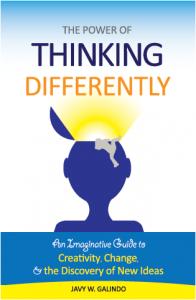[stextbox id=”download” image=”null”]The following is a post I originally wrote for The Change Blog, run by Peter. His blog is about personal change and I really recommend it for those looking to make creative changes in their lives.[/stextbox]
A percussionist has a way of creating music out of a couple twigs and an iron pot. A dancer can turn an empty room into a mosaic of movement. Why not use your own inherent creative capacities to be the artist of your own life?
We often feel trapped; unable to change directions while on the roads we travel.
But just as a writer can overcome creative blocks when staring at a blank sheet of paper, we can all overcome the blocks that prevent us from seeing creative possibilities for our lives.
I was an electrical engineer for over a decade before I decided to make my own creative career changes — going back to graduate school and becoming a published author.
It was a process consisting of a lot of sweat, doubt, and frustration. As it turns out, lots of people go through the same process.
As I chronicle in my book, The Power of Thinking Differently, the creative process is similar across disciplines—from art, business, to scientific advancement.
It is also the same for those of us wanting to make creative changes in how we make a living and how we live our lives in general.
The following ten steps to creative career changes are adapted from both the research for my book and my personal experience. Though I’ll emphasize “career” changes, the steps can be applied to any life changes you may wish to make.
I hope it provides you with a useful map to wherever it is you are meant to go.
1. List Your Reasons for Change
Begin by taking an inventory of the negative stuff. What is it about your life that you would like to change? What about it makes you unhappy?
Be as specific as possible. Write a list consisting of short declarative statements that get to the point.
It’s often easier to first figure out why we want creative change, and what we are changing from, before deciding which direction to go.
2. List Your Passions and Skills
Over time, some of us stopped making life decisions based on what makes us happy. Instead, decisions were based upon the expectations of others. We ended up living our lives based on somebody else’s story of what a good life looks like, rather than following our own internal compass.
The result is your list from step #1.
Now it’s time to reclaim your life.
Start by listing what activities, hobbies, or aspects of your current job give you joy. What gets you excited just thinking about it?
You can take a look at your own personal history to get more ideas. Sketch out your autobiography to get a sense of your life’s highlights. When you were a child, you often did things because you loved doing them. What are some examples of this?
You can also take an inventory of all the things you were, or are, naturally good at.
At the end of this step you’ll have a collage of potential aspects of your new career.
3. Explore Crazy Career Ideas
This is the stage of the creative process where businesses brainstorm, where sketch artists doodle, and where scientists experiment and hypothesize. It is also the stage where you give yourself freedom to dream up crazy career possibilities.
Wanna be a writer? What kind — for a magazine, for a newspaper, a book, for film, or a blog?
Love traveling? How about being a tour guide, or working for an airline to get free flights?
Or how about combining traveling and writing and becoming a travel author?
Relax, have fun, and simply play around with nutty ideas. Mixing and matching, making connections between alien concepts, is how creative ideas come about.
It is also the key to turning what you love into how you live.
Write down as many ideas as possible. Try to connect as many of your interests and passions and skills as you can to form interesting ways of making money. The more obscure the better. You won’t have any competition in the market place.
The key to this part of the process is to get as many ideas as possible without judging their feasibility. Your ridiculous idea about selling crotchless briefs may lead you to your life’s work in humorous clothing design.
4. Prioritize & Choose
At this point you should have a list of great ideas that you’ll want to pursue.
Now you need to filter. Now you need to look at the ones you’re most passionate about and start to judge them for their feasibility.
Einstein wrote lots of papers that nobody ever found useful, and Picasso had books of sketches that were never turned into masterpieces. But both were able to use their wild explorations to arrive at some inspired works.
You can do the same. Pick an idea that you’re most interested in and focus on it in the steps to follow.
5. Clear the Path by Realizing Your Assumptions
For many of us, we fail to fulfill our creative changes because we feel we can’t. We feel that our circumstances make it impossible to change.
Now it’s time to really stare that assumption in the face.
Take a look at where you are in your life (#1) and compare it to where you want to go (#4). What obstacles stand in your way? Write down everything you think is preventing you from pursuing your crazy career ideas.
Our mind has a tendency to exaggerate our obstacles and fears. The door we’ve never opened before can seem scary simply because it leads to something unknown.
Going through the process of realizing what those obstacles actually are may reveal to you that the emperor has no clothes. The shadow in the wall of your bedroom may just be your bedpost, and not the boogieman.
Hopefully you’ll begin to see that there’s a lot less in your way than you first thought.



